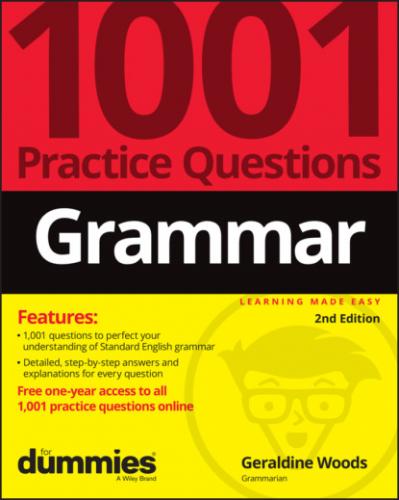If you forget to do the homework, you will receive a failing grade.
You can also reword and avoid the pronoun entirely:
Someone forgot to do the homework and will receive a failing grade.
Each applicant should explain the reasons for leaving a previous job.
Alix arrived late because of traffic.
For practice questions on pronoun agreement, see Chapter 5.
One warning: According to one study, English has nearly a million words that may be combined in varied — and grammatically correct — ways. For each question, I provide the most common response, but at times, you may come up with another answer that’s also acceptable. In such a situation, measure your version by the standards I provide in each explanation, and count yourself “right” if you’ve followed the rules.
What You’ll Find
This book contains 1,001 questions, divided into 22 chapters. I take you through parts of speech (verbs, pronouns, and so forth), parts of a sentence (subjects, verbs, objects, descriptions, and the like), and what English teachers call mechanics (punctuation and capitalization). I also cover the most common mistakes, such as incomplete sentences, commonly confused words, and nonstandard expressions. Each chapter begins with a list of topics, followed by tips and traps — points to remember when you’re answering the questions in that chapter. You don’t have to complete every question in a section, and you don’t have to work on the chapters in order. You’re in charge! Select only the topics that stump you, if you want. When you’re checking your answers and reading the attached explanations, you may discover other areas worth exploring. For example, suppose you’re asked to select the proper pronoun for a sentence. In the answer section, you see that you need a subject pronoun. The problem is that you’re not sure how to locate a subject. No worries: Turn to Chapter 4 for practice in finding subjects.
How This Workbook Is Organized
This workbook includes 1,001 questions in Part 1 and answers to all of them, plus explanations, in Part 2.
Part 1: The Questions
Here are the topics covered by the 1,001 questions in this book:
Verbs:Chapter 1 deals with locating the verb and selecting the right tense. Chapter 2 covers irregular verb forms, helping verbs, and verb forms that function as descriptions (participles, in grammar terminology). On a more advanced level, Chapter 17 deals with verbs in active and passive voice and subjunctive verbs.
Nouns and pronouns:Chapter 3 checks your knowledge of singular and plural nouns and pronouns. The questions in Chapter 6 concern pronoun case — the difference between he, him, and his, for example.
Agreement: In grammar, the principle of agreement is that singular pairs with singular and plural with plural. Chapter 4 focuses on subject-verb agreement, and Chapter 5 checks whether pronouns agree with the words they represent or refer to, also known as their antecedents.
Sentence completeness: The building block of writing is a complete sentence. The questions in Chapter 7 deal with complete sentences (the correct form in Standard English), as well as run-ons (sentences improperly joined) and fragments (incomplete sentences).
Descriptions and complements: Adding to the bare bones of the sentence, the subject-verb pair are complements and descriptions. In Chapters 8 and 9, you distinguish between an adjective and an adverb, select the appropriate form for formal speech and writing, and place it in the right spot. In Chapter 10, you work on comparisons, so that yours are clear and logical.
Capitalization: Names, quotations, seasons, titles — Chapter 11 checks whether you understand where to place a capital letter in these situations and many others.
Punctuation: Lots of people shudder when they think about punctuation, but most of the rules are logical. In Chapter 12, you practice inserting and deleting commas. Chapter 13 hits you with questions about apostrophes and quotation marks.
Parallel structure:Parallel is the word English teachers use to describe balance. In Chapter 14, you work on questions about parallelism, including lists, paired conjunctions (either/or, not only/but also, and so forth), tense, and person.
Style: Do your sentences need to go on a diet? Chapter 15 permits you to trim some repetitive or wordy sentences. Chapter 16 prods you to vary sentence patterns.
Electronic media: Do you know how to make a grammatically correct presentation slide or bulleted list? Chapter 18 questions you on this topic and tests the appropriate form and language for email and texts. In Chapter 19, you examine formal and informal English and decide when each is appropriate.
Word traps: Some word pairs can trick you — accept/except, affect/effect, rise/raise, and so on. In Chapters 20, 21, and 22, you practice choosing the appropriate word so that your writing always expresses your intended meaning.
Part 2: The Answers
Life is filled with unanswered questions (How can we achieve world peace? Where's the path to enlightenment? Do I need a ticket to get there?). Fortunately, this book is filled with answered questions. Check Part 2 for the correct answers, each accompanied by an explanation of the grammar or style point involved.
Beyond the Book
This book gives you plenty
